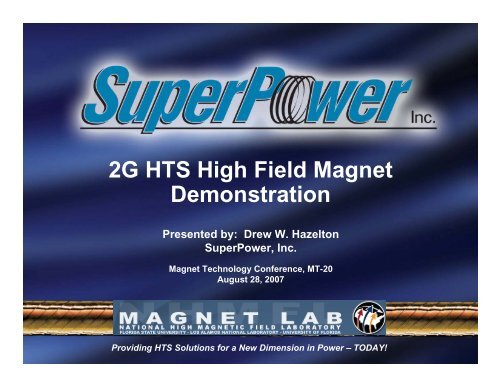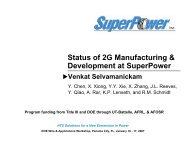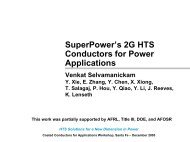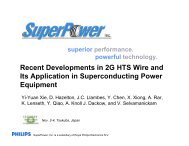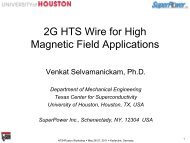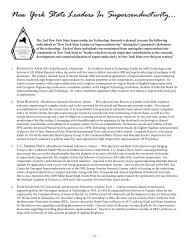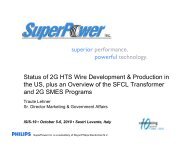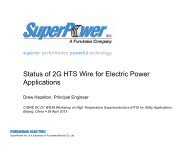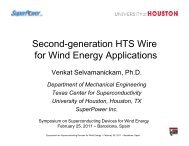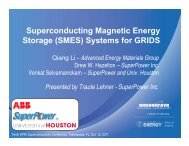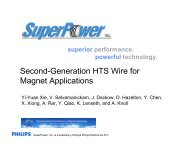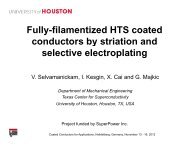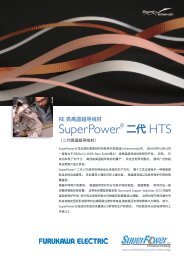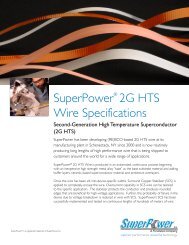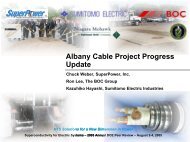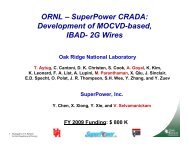2G HTS High Field Magnet Demonstration - SuperPower Inc.
2G HTS High Field Magnet Demonstration - SuperPower Inc.
2G HTS High Field Magnet Demonstration - SuperPower Inc.
You also want an ePaper? Increase the reach of your titles
YUMPU automatically turns print PDFs into web optimized ePapers that Google loves.
<strong>2G</strong> <strong>HTS</strong> <strong>High</strong> <strong>Field</strong> <strong>Magnet</strong><br />
<strong>Demonstration</strong><br />
Presented by: Drew W. Hazelton<br />
<strong>SuperPower</strong>, <strong>Inc</strong>.<br />
<strong>Magnet</strong> Technology Conference, MT-20<br />
August 28, 2007<br />
Providing <strong>HTS</strong> Solutions for a New Dimension in Power – TODAY!
Acknowledgements<br />
<strong>SuperPower</strong>, , <strong>Inc</strong>.<br />
• Jason Duval, Venkat Selvamanickam, Yi-Yuan Xie<br />
• …and the rest of the <strong>SuperPower</strong> Team<br />
• <strong>2G</strong> <strong>HTS</strong> Wire Development Program funding from Title III and DOE through UT-<br />
Battelle<br />
National <strong>High</strong> <strong>Magnet</strong>ic <strong>Field</strong> Laboratory / FSU<br />
• Zhijun Chen, David Larbalestier, Denis Markiewicz, Ed Miller, Patrick Noyes,<br />
Ken Pickard, Ulf Trociewitz, and Huub Weijers<br />
• A portion of this work was performed at the National <strong>High</strong> <strong>Magnet</strong>ic <strong>Field</strong><br />
Laboratory, which is supported by NSF Cooperative Agreement No. DMR-<br />
0084173, by the State of Florida, and by the DOE<br />
MT-20 August 28, 2007 –1–
<strong>SuperPower</strong>’s <strong>2G</strong> wire utilizes high strength substrates<br />
coupled with high throughput processing<br />
<strong>SuperPower</strong>’s <strong>2G</strong> <strong>HTS</strong> wire is based on high throughput IBAD MgO and<br />
MOCVD processes.<br />
Use of IBAD as buffer template provides us choice of any substrate.<br />
• Advantages of IBAD are high strength, low ac loss (non-magnetic, high<br />
resistivity substrates) and high engineering current density (ultra-thin<br />
substrates)<br />
<strong>High</strong> throughput is critical for low cost <strong>2G</strong> wire and to minimize capital<br />
investment.<br />
20μm Cu<br />
2 μm Ag<br />
1 μm <strong>HTS</strong><br />
~ 30 nm LMO<br />
~ 30 nm Homo-epi MgO<br />
~ 10 nm IBAD MgO<br />
< 0.1 mm<br />
50μm Hastelloy substrate<br />
20μm Cu<br />
MT-20 August 28, 2007 –2–
Long length processing of <strong>2G</strong> wire demonstrated<br />
250<br />
Critical current<br />
(A/cm)<br />
200<br />
150<br />
100<br />
50<br />
0<br />
Jan. 2007<br />
0<br />
50<br />
100<br />
150<br />
200<br />
250<br />
300<br />
350<br />
400<br />
450<br />
500<br />
550<br />
600<br />
77 K, Ic measured every 5 m using continuous dc<br />
currents over entire tape width of 12 mm (not slit)<br />
Position (m)<br />
Minimum Ic = 173 A/cm over 595 m<br />
Ic × Length = 102,935 A-m<br />
Uniformity over 595 m = 6.4%<br />
Process<br />
(single pass)<br />
IBAD MgO<br />
Homo-epi MgO<br />
LMO<br />
MOCVD<br />
Speed of 4 mm tape<br />
(m/h)<br />
360<br />
213<br />
360<br />
135<br />
MT-20 August 28, 2007 –3–
Critical current properties of the <strong>2G</strong> wire make it ideal for<br />
lower temperature, high field applications<br />
Data (solid figures) taken on bridge sample.<br />
Dashed red line is hypothetical curve.<br />
J c<br />
( MA/cm 2 )<br />
45<br />
40<br />
35<br />
30<br />
25<br />
20<br />
15<br />
10<br />
5<br />
4.2K//c<br />
4.2K//ab<br />
0<br />
0 5 10 15 20 25 30 35<br />
μ 0<br />
H (Tesla)<br />
J e<br />
( A/mm 2 )<br />
10000<br />
8000<br />
6000<br />
4000<br />
2000<br />
0<br />
0 3 6 9 12 15 18 21 24 27 30 33<br />
μ 0<br />
H (Tesla)<br />
4.2K//c<br />
4.2K//ab<br />
Superconductor critical current density<br />
Data by Z. Chen at NHMFL / FSU (2007)<br />
Conductor critical current density<br />
thickness ~ 95 μm<br />
MT-20 August 28, 2007 –4–
Mechanical properties of <strong>2G</strong> wire are ideal for high stress<br />
applications<br />
Stress-strain traces for <strong>SuperPower</strong> <strong>2G</strong> YBCO at 76K. <strong>Inc</strong>luded are a<br />
trace of the base substrate material, Hastelloy C276 which dominates the<br />
conductor mechanical properties. Note the impact of copper stabilizer<br />
which slightly lowers the overall composite strength.<br />
Measurements conducted at NIST by Ekin et al (2004)<br />
MT-20 August 28, 2007 –5–
50 micron substrate tape shows superior bend strain<br />
characteristics<br />
Ic/Ic(original)<br />
100%<br />
90%<br />
80%<br />
70%<br />
60%<br />
50%<br />
Bend at R.T. and Test While held on Mandrel<br />
100 micron substrate<br />
4 mm wide with 20<br />
micron surround Cu<br />
50 micron substrate<br />
4 mm wide and<br />
surround Cu<br />
50 micron substrate<br />
12 mm wide no Cu<br />
-10 -11 -12 -14 -16 -19 -23 24 19 16 14 12 10 9<br />
Compressive<br />
Bend diameter (mm)<br />
Tensile<br />
95%<br />
Maximum Bend Strain = +/- t / D ~ 95 μm / 11000 μm = 0.86 % (~ 0.45 % on the YBCO)<br />
MT-20 August 28, 2007 –6–
<strong>High</strong> field insert coil construction<br />
Conductor:<br />
Dimensions: 4 mm wide x<br />
95 microns thick<br />
Substrate: 50 micron Hastelloy<br />
<strong>HTS</strong>:<br />
~ 1 micron YBCO<br />
Stabilizer: ~ 2 micron Ag on YBCO<br />
Tape Ic<br />
Coil Winding<br />
~ 20 microns of surround<br />
copper stabilizer per side<br />
72 – 82 A, 77 K, sf<br />
Double Pancake Construction<br />
Dry Wound (no epoxy)<br />
Kapton polyimide insulation (cowound)<br />
Overbanding: 316 Stainless Steel<br />
Coil ID<br />
Winding ID<br />
Winding OD<br />
Coil Height<br />
# of Pancakes<br />
<strong>2G</strong> tape used<br />
# of turns<br />
Coil Je<br />
Coil constant<br />
9.5 mm (clear)<br />
19.1 mm<br />
~ 87 mm<br />
~ 51.6 mm<br />
12 (6 x double)<br />
~ 462 m<br />
~ 2772<br />
~1.569 A/mm 2 per A<br />
~ 44.4 mT/A<br />
MT-20 August 28, 2007 –7–
NHMFL facilities provide 19T axial background field<br />
Insert coil tested in NHMFL’s unique, 19-tesla,<br />
20-centimeter wide-bore, 20-megawatt Bitter<br />
magnet<br />
<strong>2G</strong> HF Insert Coil Showing Terminals, Overbanding and<br />
Partial Support Structure. Flange OD is 127 mm.<br />
MT-20 August 28, 2007 –8–
Test setup at NHMFL<br />
Data Acquisition<br />
<strong>HTS</strong> magnet<br />
power supply<br />
Shunt<br />
Fault<br />
detection<br />
1.5 Ω Dump<br />
resistor<br />
Insert & Hall data<br />
YBCO insert<br />
Large Bore<br />
Resistive magnet<br />
Hall sensor<br />
MT-20 August 28, 2007 –9–
Typical V-I trace (19T background field)<br />
1.00E+00<br />
lead-lead voltage in 19 T background<br />
lead-lead<br />
Pancake 12<br />
1.00E-01<br />
1.00E-02<br />
Ic = 175 A<br />
inductive voltage @ 5.9<br />
A/min<br />
Voltage [V]<br />
1.00E-03<br />
1.00E-04<br />
1.00E-05<br />
inductive voltage @ 3.7 A/min<br />
1.00E-06<br />
1.00E-07<br />
1 10 100 1000<br />
Current<br />
MT-20 August 28, 2007 –10–
Hall probe data shows linear field generation<br />
Hall probe signal showing non-linearity of sensor and near-perfect field generation by insert<br />
30<br />
0.20<br />
28<br />
Hall<br />
linear fit, 44.4 mT/A<br />
deviation from linear<br />
0.15<br />
26<br />
0.10<br />
Central <strong>Field</strong> [T] .<br />
24<br />
22<br />
current reversal loop<br />
0.05<br />
0.00<br />
non-linearity [T] .<br />
20<br />
pause in ramping<br />
-0.05<br />
19 T Axial<br />
Background <strong>Field</strong><br />
18<br />
0 50 100 150 200 250<br />
Insert current [A]<br />
-0.10<br />
MT-20 August 28, 2007 –11–
<strong>High</strong> field insert coil achieves world records for highest<br />
<strong>HTS</strong> field, highest magnetic field by a SC magnet<br />
Peak hoop stress ~ 215 MPa,<br />
well below tape limit<br />
Ic of Tapes in Coil<br />
4.2 K Coil Ic - self field<br />
72 A – 82 A<br />
(77K, sf)<br />
221 A<br />
19T background<br />
self field<br />
4.2 K Amp Turns @ Icself<br />
field<br />
612,612<br />
30.0<br />
4.2 K Je @ Ic, self field<br />
346.7 A/mm 2<br />
Central <strong>Field</strong> (T)<br />
25.0<br />
20.0<br />
15.0<br />
10.0<br />
5.0<br />
0.0<br />
26.8 T @ 175 A<br />
9.81 T @ 221 A<br />
0 50 100 150 200 250<br />
Current (A)<br />
4.2K Peak Radial <strong>Field</strong><br />
@ Ic, self field<br />
4.2 K Central field –<br />
self field<br />
4.2 K Coil Ic – 19 T<br />
background (axial)<br />
4.2 K Amp Turns @ Ic –<br />
19 T background (axial)<br />
4.2 K Je @ Ic, 19 T<br />
background (axial)<br />
4.2 K Peak Radial <strong>Field</strong><br />
@ Ic, 19 T bkgd (axial)<br />
4.2K Central <strong>Field</strong> – 19<br />
T background (axial)<br />
3.2 T<br />
9.81 T<br />
175 A<br />
485,100<br />
274.6 A/mm 2<br />
2.7 T<br />
26.8 T<br />
MT-20 August 28, 2007 –12–
Summary<br />
• We have not reached the limit of <strong>2G</strong> <strong>HTS</strong> wire capability<br />
• Coil performance limited by operation of Pancake 12<br />
• Stress limit on the wire still has significant margin<br />
Hoop stress ~ 215 MPa vs. ~ 600 MPa limit<br />
• <strong>2G</strong> <strong>HTS</strong> wire with 50 micron Hastelloy substrate enables high<br />
winding pack Je<br />
• <strong>2G</strong> <strong>HTS</strong> wire is available in lengths and quantity to enable<br />
development in high field magnet design and construction<br />
• 30 T (and beyond) is within our grasp……<br />
MT-20 August 28, 2007 –13–
Questions?<br />
Thank you for your interest!<br />
For further information about <strong>SuperPower</strong> and to see the coil,<br />
please visit us at Booth No. 5<br />
or at:<br />
www.superpower-inc.com<br />
or e-mail: info@superpower-inc.com<br />
MT-20 August 28, 2007 –14–


